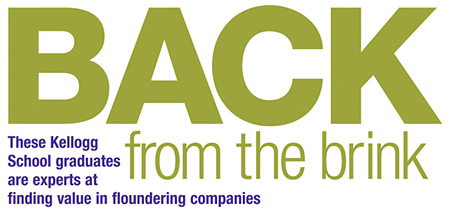
By
Kari Richardson
Bettina
Whyte '75 lives from crisis to crisis, showing up when the
balance sheet needs mending or customers have abandoned a
company in droves.
Whyte,
a principal at the New York office of Alix Partners LLC, repairs
companies for a living, signing on with firms that have hit
a rough patch. When she's helped steer the company back on
course --- or when circumstances warrant, helped it navigate
the murky waters of bankruptcy --- she's on to the next set
of problems.
| |
"People
in this industry, rather than being undertakers,
are leaders. They have talents beyond firing people.
They have a way to find the weak spots and fix
them. And they have ways of gaining people's trust
quickly, because if you don't, you won't last
long."
—
Prof. James Shein |
|
| |
|
| |
|
| |
|
"I've
been described as a crisis junkie," says Whyte, who began
her career working with problem loans in commercial lending
and who last year served as president of the more than 10,000-member
American Bankruptcy Institute. "I wouldn't want to be the
CEO or the CFO of a single corporation. I like continually
finding myself in different circumstances and I like solving
problems."
The Kellogg
School graduate counts herself among the ranks of turnaround
experts --- professionals who don't run away from corporate
trouble, but actually seek it out. Turnaround professionals,
and others who find their calling fixing troubled firms, specialize
in getting to the heart of what's ailing a company and finding
new solutions to problems that are often deeply ingrained
in a firm's culture.
It's
not a job for the faint of heart.
The
open wound
Turnaround
specialists routinely must use imperfect information to make
split-second decisions that have profound and lasting consequences.
(One such professional likens the decision-making process
to "ready, fire, aim.") Day in and out, they lead workplaces
buzzing with anger, hostility, severe stress and confusion.
Top managers
often have made a hasty exit as part of the effort to fix
what's wrong, and the turnaround expert's presence may have
been mandated by a lender when the company defaulted on a
loan.
"Turnaround
experts or restructuring officers have to be prepared for
constant change in terms of both assignments and new problems
that will come at them," says Adjunct Professor of Management
and Strategy James
Shein, a lawyer with the Chicago office of McDermott,
Will & Emery and businessman who has guided several companies
back on the path to profitability. "They have to be prepared
to handle all sorts of problems in multiple disciplines, often
without the cooperation of people in the organization."
"Chainsaw"
Al Dunlop, the ex-CEO of Sunbeam who sought to bolster corporate
profits by hacking thousands of jobs, may have done damage
to the public's perception of a corporate restructuring guru.
Today's turnaround professionals focus on the good they do,
and the restructurers leading change at Enron, WorldCom and
others have highlighted their role for the public.
According
to the Web site of the 6,600-member Turnaround Management
Association, restructuring professionals routinely save jobs,
preserve entire companies or parts of them and return money
to shareholders and creditors.
 |
|
| Bettina
Whyte '75 |
|
| |
|
"People
in this industry, rather than being undertakers, are leaders,"
Shein says. "They have talents beyond firing people. They
have a way to find the weak spots and fix them. And they have
ways of gaining people's trust quickly, because if you don't,
you won't last long."
For those
leading change, denial is one of the most potent challenges
to establishing trust.
Bettina
Whyte quietly followed the path of a struggling company for
two years before its board of directors hired her to sort
out its financial troubles. An angry group of senior managers
greeted her when she arrived the first day. Her help wasn't
needed, they said. But when Whyte asked the CFO whether the
firm could meet payroll the following week, beads of perspiration
appeared on his forehead. He confessed he didn't know how
much money the company had banked.
"We are
the open wound or the root canal," Whyte says. "Management
doesn't really want to see us because it suggests they failed.
In reality, they may or may not have failed."
After
years in the industry, she has fine-tuned her strategy for
getting remaining managers to play a role in the changes.
"One
of the things I do almost immediately is bring every member
of the executive team in for an hour to talk with me alone,"
she says. "During that hour or two, I find out a lot about
the individual. I explain that things are going to be very
different now. That we are a team trying to reach a realistic,
but successful, outcome. And that if they don't think they
can be part of that team, I want them to quit as soon as possible.
You can't have someone on board who's going to be disruptive
or negative."
If
it's broke, it better be fixed
Simply deciding which pressing task to tackle first is often
a monumental challenge for those who enter a floundering firm.
Carroll
Mackin '96 earned his stripes in corporate renewal when he
bought a bankrupt maker of specialty aluminum, stainless steel
and copper nails.
"All
of these things are broken," Mackin says of his early days
managing Great Northern Manufacturing. "You have to prioritize
what you do first."
"We had
a ton of broken business processes," he recalls. "We didn't
have a good method for selling our product. We didn't have
good vendor relationships. We didn't have a good process for
invoicing. The answer was simple — fix them."
Mackin
set to work. He hired capable people to fill critical roles
in the company, mended ineffective business methods, forged
new relationships with vendors, and ultimately, repaired damage
to the company's reputation. His perspective as an outsider
enabled him to make many of the necessary structural and strategic
changes, he says.
Today,
he takes pride in what he's accomplished while drawing on
almost all of the skills he learned while an MBA student at
the Kellogg School: the company has graduated from a substantial
loss to strong profitability, gross margins have more than
doubled since he bought it, and 20 workers have had steady
jobs in a topsy-turvy economy.
"The
end result may not be so sexy," he says. "It's business school
101. But implementation is a lot more work than it appears."
Restructuring
officers and entrepreneurs like Mackin offer a fresh perspective
and new skills to apply to problems that often have deep roots.
Shein
was once part of an early-stage turnaround at an appliance
parts manufacturer in which 100 percent of employees stayed
in their jobs. Working with the company president, he developed
a list of essential tasks to be completed to set the firm
on a fresh course.
But when
he checked back one month later, Shein discovered the president
hadn't completed any of the items on their mutually agreed-upon
list.
"He said
he had divided the items on the list into two categories,"
Shein says. "Half of them he didn't know how to do, and the
other half he couldn't bring himself to do."
The solution:
Shein hired a person to work side-by-side with the president,
identifying new ways to accomplish key tasks and finding new
roles within the company for a couple of workers who had been
promoted beyond their expertise.
"If the
CEO knew how to do it, chances are it would already be done,"
he says.
Next
page: "Too often, by the time someone
gets to us all that's left is liquidation"
1 | 2
|



